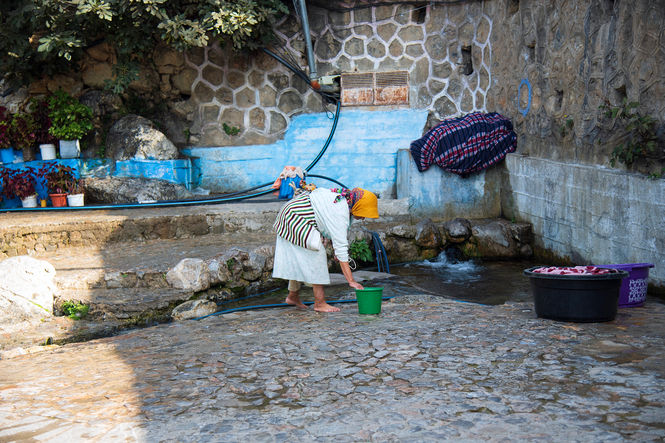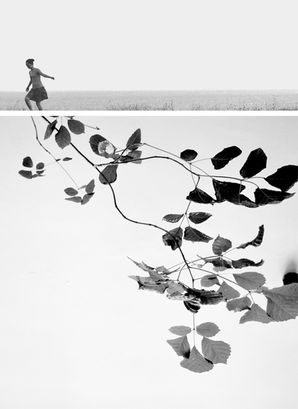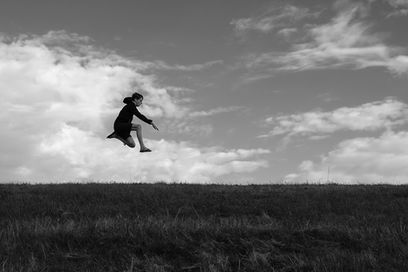
THREADS OF MOROCCAN LIFE
Through gestures of work and moments of community, Kat Puchowska reveals Morocco’s overlooked beauty.
October 19, 2025
INTERVIEW
PHOTOGRAPHY Kat Puchowska
INTERVIEW Melanie Meggs
The question of visibility, understood as whose lives are acknowledged and by what visual means, lies at the center of Kat Puchowska’s long-term project Morocco: The Rhythm of the Street. Between 2017 and 2024, Kat undertook repeated journeys across the country, moving through the winding souks of Fes, the hilltop terraces of Chefchaouen, the alleyways of Meknès, and the smaller villages of the Middle Atlas. Over these seven years, she has built an extensive archive of photographs that draw attention away from the language of state-led progress and toward the modest yet vital rhythms of survival and creativity that sustained daily life in Morocco during this period.
Living between cultures, dividing her time between Spain and the United Kingdom after growing up in Poland, Kat brings a sensitivity to questions of belonging and identity that shapes how she approaches these spaces. Her perspective has also been shaped by years of travel to more than forty countries, experiences that sharpen her awareness of both the uniqueness of place and the quiet continuities that connect people across borders.
For Kat, photography begins with an ethic of respect, a commitment to observing without intrusion and to letting daily life speak for itself. She works only with natural light and avoids staging or interference, positioning herself instead as a patient witness. The images she creates are the result of immersion and a careful negotiation between distance and intimacy. They emphasize process over performance, allowing labor to be seen not as a statistic or abstraction but as a lived reality embedded in social and cultural space.
The photographs themselves operate at several registers. At one level, they document markets, alleyways, workshops, and gestures, the physical and social infrastructures of the informal economy. At another, they function as studies of cultural identity, tracing how clothing, architecture, and everyday interaction articulate Morocco’s layered histories. Kat’s own experience of navigating life across multiple cultural contexts, combined with her extensive travel, lends her work a particular attentiveness to these intersections, sharpening her awareness of how place and identity continually shape one another. Each photograph holds both the specificity of place and the broader universality of human endurance. Rather than isolated impressions, they accumulate into a composite record that is at once cultural and economic, showing how Morocco’s diverse histories are inscribed in everyday gestures while also revealing the dependence of entire communities on forms of labor that remain unacknowledged in official accounts of progress.
Kat unsettles conventional economic storytelling. Her photographs invite us to think critically about how modernization is narrated, and whose labor is excluded from its metrics. What emerges is an argument for photography as a mode of counter-history, one that challenges dominant frameworks of visibility and insists on the importance of lived experience.
As The Rhythm of the Street unfolds, the work reveals itself as one shaped by patience, empathy, and a deep respect for the lives it portrays. Kat’s Morocco is not a place of stereotypes or display, but of small gestures that carry weight: the rhythm of a market, the pause of rest in the shade, the quiet dignity of work done day after day. What follows is a conversation with Kat Puchowska about her project, her journey as a photographer, and the values that continue to shape her way of seeing.

“Travelling abroad opened my eyes to the diversity of human life — the differences and similarities between cultures fascinated me. Learning languages and spending time in other countries made me want to tell people’s stories, to share experiences that might otherwise go unnoticed. Those early journeys shaped my approach: observing, listening, and capturing moments that reveal both individuality and shared humanity.”
IN CONVERSATION WITH
KAT PUCHOWSKA
TPL: How did you first come to photography, and what role did it play in your life before it became a central pursuit? When you look back now, does that early period feel connected to the work you’re making today, or does it feel like a different chapter?
KAT: I started photographing when I was 14. I loved capturing people. That early curiosity quickly grew into a deeper passion, and I decided to study photography at college and then at university. Over time, my focus gradually shifted from fashion to culture and documentary portraiture, but that initial fascination with composition, colour, and capturing personality still informs how I see the world today.
TPL: Morocco has held your attention for seven years. What is it about this country that continues to draw you back? Do you feel your relationship with Morocco has changed as the project has unfolded?
KAT: Morocco is endlessly rich in life and detail. Its streets, markets, and villages are full of people living at their own pace, negotiating daily life with resilience, creativity, and generosity. Over the years, my relationship with Morocco has deepened. What started as curiosity became familiar to me, and now returning feels like entering a rhythm of life I know but never take for granted!! Every visit reveals new gestures, exchanges, and moments that remind me why I keep photographing there.
TPL: Was there a particular image or moment that crystallized what Morocco: The Rhythm of the Street is truly about for you? How did that moment influence the way you photographed afterwards?
KAT: In Azrou, at a village market, I watched farmers, merchants, and neighbours trading and chatting - a space that embodies both daily life and the local economy. That day, I wanted to buy pomegranates, but the seller didn’t have change for my large notes. A woman who was standing close by bought them for me and wouldn’t accept my money. Even without speaking the same language, we shared a smile and a beautiful moment of connection. Experiences like this happened often in Morocco, and at first, I couldn’t understand how people who live more modestly than I do could be so generous and kind. Moments like these crystallise the project for me: dignity in everyday work, the warmth of community, and the beauty in small gestures.
TPL: Street photography is often fast and opportunistic, yet your approach is slow and immersive. Was this a deliberate decision, or something that evolved naturally?
KAT: It evolved naturally. I tried working quickly at first, but I realised my best images came when I slowed down, observed, and waited. I pay attention to details others might overlook - a glance, a gesture, a fleeting exchange. For me, photography isn’t about chasing moments; it’s about settling into a space until it reveals itself. I can say my style reflects who I am: patient, curious, sometimes shy, and interested in quiet truth rather than spectacle.
TPL: How do you decide when to remain a silent observer and when to step into conversation or connection with those you photograph? Has engaging with people ever transformed the image you ended up making?
KAT: I try to be sensitive and humble, aware of the space I enter. Often, simply observing is enough, but sometimes a smile, a few words, or a shared gesture builds trust and opens up moments I couldn’t capture otherwise. Engaging with people has occasionally changed what I photographed, revealing subtle emotions or interactions I might have missed. It’s a balance between respect, curiosity, and attentiveness.
For me, photography isn’t about chasing moments; it’s about settling into a space until it reveals itself.

TPL: Growing up in Poland and now living between Spain and the United Kingdom, and travelling to more than forty countries, how has this breadth of movement influenced your way of seeing, and what remains constant in the way you approach new places?
KAT: Living and travelling across cultures has made me attentive to both difference and continuity. I notice the gestures, habits, and environments that are unique, but also the threads that connect people everywhere. What remains constant in my approach is respect and curiosity: observing without judgement, and giving people space to exist naturally, while still being present enough to notice the small details that make a story.
TPL: How do you negotiate the balance between being an “outsider” and building a deeper connection with the communities you photograph? Do you see being an outsider as a limitation, or does it sometimes give you a perspective that locals might overlook?
KAT: I see being an outsider as both a challenge and a gift. I can’t fully experience a place as someone who belongs there does, but I often notice details others take for granted. I approach communities with humility, openness, and respect. Building connection doesn’t mean pretending to belong; it means listening, observing, and trying to see the world through their eyes, while letting people remain themselves.🙂
TPL: Looking ahead, what do you hope your work will leave behind — for the people you photograph, for audiences, and for yourself? Do you imagine your photographs as part of a personal archive, a public record, or something more fluid that changes meaning over time?
KAT: I hope my photographs give visibility and dignity to the people I document, celebrating the quiet strength of everyday life. For audiences, I want to inspire curiosity - to pause, look closer, and see the extraordinary in ordinary moments. In a world dominated by phones and distraction, where we often stay in our own bubbles, I hope my images encourage reconnection with others. I also encourage mindful travel: learning about other cultures, engaging with local customs, and seeking understanding. For myself, the work is a personal archive and a record of cultures in motion. By slowing down and noticing, I capture the intimate moments that bring these stories to life.
TPL: Is there another place or project already forming in your mind, and where might your travels take you next? If we were to meet you three years from now, where do you imagine your camera will have taken you?
KAT: Yes! I’m currently working on a project in Central Asia, focusing on Tajikistan and Kyrgyzstan. I’m fascinated by how traditions and daily routines unfold against dramatic, often harsh landscapes, and how communities adapt to scarcity, isolation, and change. In three years, I imagine I’ll still be immersed in this work, documenting the resilience, rituals, and quiet dignity of people whose lives are often overlooked in global narratives. At the same time, I remain open to new opportunities; sometimes projects find me, and I follow them wherever they lead.
TPL: Every photographer’s bag says something about how they move through the world. If we were to look inside yours, what would we find — both in terms of tools and the small things you can’t leave behind? And is there anything still on your wishlist that you’re hoping to add one day?
KAT: In my bag, you’d find my Nikon 750 with a 24–120mm for versatility, a 50mm for everyday moments, and an 85mm for portraits. I carry a notebook, translation apps or guides, and sweets for children, who often want my attention while I work. In the future, I’d love a telephoto lens and to expand into short films, capturing the flow and small gestures of everyday life in both still and moving images.
TPL: When you are not photographing or travelling, what else might we find you doing?
KAT: You’d probably find me walking in nature, spending time with loved ones, or simply sitting outside and watching people pass by. I’m always planning my next trips and keeping up with world news. I also love learning new languages; hopefully, one day I can master Arabic. I often go to live music concerts, which often inspire me. These moments recharge me and remind me why I’m drawn to photographing the world! - Please remember to be kind to other people 😊

Kat Puchowska’s Morocco: The Rhythm of the Street demonstrates how documentary photography can function as both record and reflection. Her images foreground the infrastructures of Moroccan everyday life and in doing so they unsettle the dominance of state-led narratives of development. What becomes visible is an alternative archive. Kat’s position, shaped by her own experiences across borders, inflects this work with sensitivity to belonging and difference, while her methodology of patience and respect affirms the ethical possibilities of photographic practice. As her journey continues into new geographies, the critical force of her work lies in its insistence that creativity and community are not peripheral but central to understanding how people inhabit the world.
















































